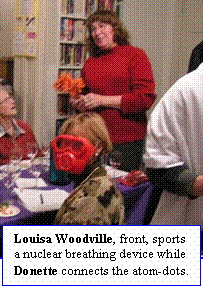John Marshall Chapter
 Although some of us were kidding about the Livermore nuke-und-grape
connection, Donette was not. Reminding us that spent nukes also are
packaged in glass, she passed pieces of silicon around for our
inspection. And just as grape pickers wear protective masks as they
pick grapes (to protect the grapes from them, we suspect), so do lab
workers. And she forthwith donned two unsuspecting bystanders with
nuclear gas mask and sheeting. Donette visits the Labs regularly, and
she knows these things.
Although some of us were kidding about the Livermore nuke-und-grape
connection, Donette was not. Reminding us that spent nukes also are
packaged in glass, she passed pieces of silicon around for our
inspection. And just as grape pickers wear protective masks as they
pick grapes (to protect the grapes from them, we suspect), so do lab
workers. And she forthwith donned two unsuspecting bystanders with
nuclear gas mask and sheeting. Donette visits the Labs regularly, and
she knows these things. | Your RSVP can work wonders. Knowing who-all is coming makes for better planning and a better meeting all around. It’s just a Martha Stewart good thing. So do it. Mary Anne has automated the process. Simply click on this link and be whisked to where all you do is enter an email address with your member name(s) and guest name(s). |
Jorma [Kaukonen, one of the founding members of the Jefferson Airplane] named the band. "I had this friend up in Berkeley, Steve Talbot, and he came up with funny names for people," explains Jorma. "His name for me was Blind Thomas Jefferson Airplane (for blues pioneer Blind Lemon Jefferson). When the guys were looking for band names and nobody could come up with something, I remember saying, 'You want a silly band name? I got a silly band name for you!' "Jorma’s wife Vanessa wrote me that Steve Talbot died many years ago, she knew not when or whereof. The life of an avowed anarchist may be nasty, brutish and short, especially if he ventures outside of Berkeley. But in his time, Ransom T certainly left a footnote in the history of rock music, and he inspired at least two young men along the way. And speaking for one of them – the callow young jerk from the ‘burbs – at least one of us is still grateful to him 40 years later.